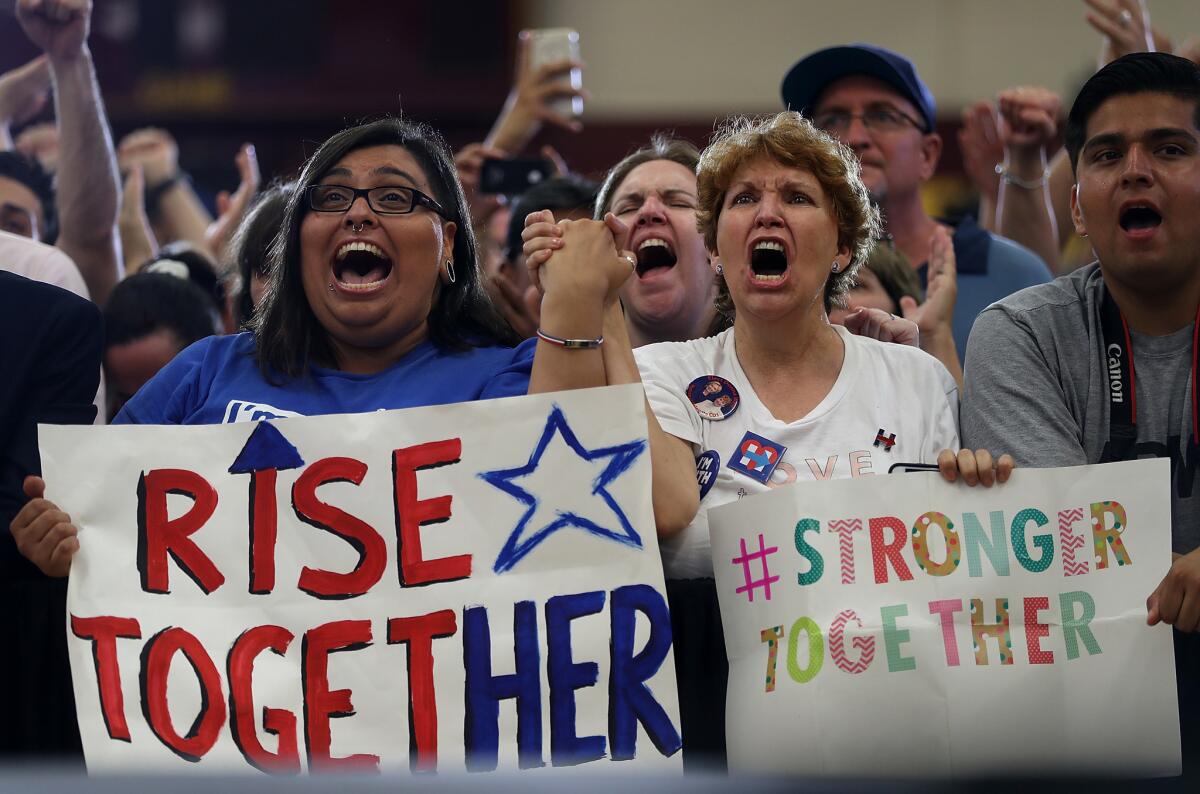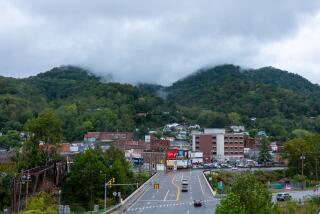Analysis: California’s presidential party is over, and here are some lessons

- Share via
The presidential campaign has lumbered off, not to come back again this year except for the occasional fundraising event.
Votes from California’s Tuesday primary are still being counted, but the results at the presidential level will not change. Donald Trump cinched the Republican nomination weeks ago, and won the GOP vote in California. Hillary Clinton clinched the Democratic nomination, also unofficially, the night before the California vote, and defeated Bernie Sanders among those who cast Democratic ballots here.
People may ignore what happened in this state; California is so reliably Democratic in the presidential general election that Trump’s assertion that he could be competitive here in November prompted open laughter.
But there are lessons for November from the California contest. Here are a few.
Registering doesn’t necessarily mean voting
California elections officials nearly drowned in a tsunami of registrations in late spring. The final pre-primary registration numbers showed a net increase of 646,000 voters — and because that took into account those dropped from the rolls, the number of new voters was actually higher. Most new registrants were Democrats, and young ones, giving great hope to Sanders’ campaign that he would benefit.
Given the election results, it seems clear that many of the new voters did not cast ballots, whether because it seemed pointless or was just too difficult.
Paul Mitchell, a voting specialist, predicted before the election one reason why registration might not mean a huge jump in the number of ballots cast.
“Voting isn’t as exciting as that moment when you see something on TV, horrific or exciting, and get your laptop and register to vote,” he said.
That may particularly be true when the air has come out of the balloon the day before, with the announcement by news organizations that Clinton had won a majority of delegates needed for the nomination.
Full results of the California primary »
Big crowds don’t mean big victories
One of the biggest anomalies this year has been the huge disconnect between Sanders’ giant crowds and his eventual losses. In Ohio, New York, Pennsylvania and California, to cite four states, Sanders drew massive audiences that seemed even more so because Clinton’s events were so small. But neither was what it seemed.
Sanders, for example, drew tens of thousands to multiple events in New York, but in the crowds were voters registered to other parties, voters registered in other states, and tourists from other countries. All were attracted to Sanders; not all could vote for him.
The same was true in California. Sanders had more than his share of impressive gatherings in the state. But he also became the political equivalent of the Grateful Dead, drawing a band of traveling supporters to multiple events. In a long line at his event in Visalia, supporters talked about how they’d gone to his rally the night before in Bakersfield and planned to go to a subsequent one in Fresno. Three events each, but each had only one vote last Tuesday.
Trump’s events, similarly, feature giant crowds.
Clinton, by contrast, kept her rallies small to avoid something all politicians abhor — cameras panning over a half-filled site. It’s not that she didn’t have supporters; it was that her supporters were not always the rallying kind, either because they were at work or because the hassle didn’t seem worth it.
“I’m not going to go to a Clinton rally—what would I learn at a Clinton rally?” Lisa von Schlegell, a Clinton supporter from Monterey County, said in a pre-election interview when marveling the numbers of people showing up for Sanders.
Data remains important, Trump’s views notwithstanding
In every campaign, candidates use big picture and detailed information. The big picture: which states are off the table, which are guaranteed and which are up in the air? Those judgments determine where money is spent. (Hint: It won’t be in California, by either side.) Detailed data tell a campaign who its voters are, and how to reach them.
Trump has scoffed at developing the sort of detailed data collection that has been the mark of successful candidates for many cycles now. In a May interview with the Associated Press, he called such efforts “overrated” and suggested that his campaign would depend on his giant gatherings.
But California showed data’s importance. It helped vault Clinton over a momentum candidate in California for the second time — in 2008 over Barack Obama, and this year over Sanders.
Data gathered from elections officials and other sources allowed the Clinton campaign to track whether its supporters had asked for mail-in ballots, and whether they had cast them. It allowed the campaign to pinpoint in which of several languages those voters should be persuaded. Before the campaign really arrived in California, Clinton’s team was able to bank early votes.
Once Clinton descended on the state, data allowed her campaign to figure which groups of voters were open to her message. It’s never accidental when, two days before an election, a candidate spends an hour in Vallejo, as Clinton did, talking to multi-ethnic voters. (She’s currently winning Solano County, where Vallejo is located, by almost 14 points, which is higher than her statewide average.)
Such operations are built campaign after campaign, and they are best built by presidential candidates, the biggest draw for voters in any general election. If Trump hews to his reluctance to utilize that common tool, it could hurt not only his candidacy but Republicans further down the ticket, and further into the future.
Twitter: @cathleendecker. For more on politics, go to latimes.com/decker and subscribe to the free daily newsletter.
ALSO:
Clinton up, Trump down after a week that flipped the presidential race
Clinton, finally breaking one glass ceiling, readies for a gender battle with Trump
Clinton and Sanders are a study in contrasts on the final weekend of California campaigning
Race to 270: Interactive Electoral College map
Updates on California politics
Live coverage from the campaign trail
More to Read
Get the L.A. Times Politics newsletter
Deeply reported insights into legislation, politics and policy from Sacramento, Washington and beyond. In your inbox twice per week.
You may occasionally receive promotional content from the Los Angeles Times.











